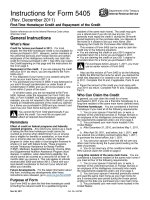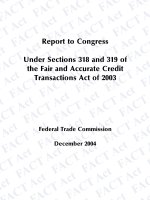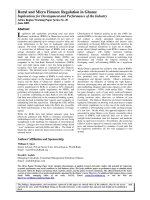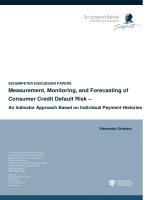saunders & allen - credit risk measurement in and out of the financial crisis, 3e (2010)
Bạn đang xem bản rút gọn của tài liệu. Xem và tải ngay bản đầy đủ của tài liệu tại đây (3.25 MB, 398 trang )
E1FFIRS 02/27/2010 1:15:59 Page 1
Credit Risk
Measurement In
and Out of the
Financial Crisis
E1FFIRS 02/27/2010 1:15:59 Page 2
Founded in 1807, John Wiley & Sons is the oldest independent publishing
company in the United States. With offices in North America, Europe, Aus-
tralia and A sia, Wiley is globally committed to developing and marketing
print and electronic products and ser vices for our customers’ professional
and personal knowledge and understanding.
The Wiley Finance series contains books written specifically for finance
and investment professionals as well as sophisticated individual investors
and their financial advisors. Book topics range from portfolio management
to e-commerce, risk management, financial engineering, valuation and
financial instrument analysis, as well as much more.
For a list of available titles, please vi sit our Web site
at
www.Wiley
Finance.com.
E1FFIRS 02/27/2010 1:15:59 Page 3
New Approaches to Value at
Risk and Other Paradigms
Third Edition
ANTHONY SAUNDERS
LINDA ALLEN
John Wiley & Sons, Inc.
Credit Risk
Measurement In
and Out of the
Financial Crisis
E1FFIRS 02/27/2010 1:15:59 Page 4
Copyright # 2010 by Anthony Saunders and Linda Allen. All rights reserved.
Published by John Wiley & Sons, Inc., Hoboken, New Jersey.
Published simultaneously in Canada.
No part of this publication may be reproduced, stored in a retrieval system, or transmitted in
any form or by any means, electronic, mechanical, photocopying, recording, scanning, or
otherwise, except as permitted under Section 107 or 108 of the 1976 United States Copyright
Act, without either the prior written permission of the Publisher, or authorization through
payment of the appropriate per-copy fee to the Copyright Clearance Center, Inc., 222
Rosewood Drive, Danvers, MA 01923, (978) 750-8400, fax (978) 646-8600, or on the web at
www.copyright.com. Requests to the Publisher for permission should be addressed to the
Permissions Department, John Wiley & Sons, Inc., 111 River Street, Hoboken, NJ 07030,
(201) 748-6011, fax (201) 748-6008, or online at />Limit of Liability/Disclaimer of Warranty: While the publisher and author have used their best
efforts in preparing this book, they make no representations or warranties with respect to the
accuracy or completeness of the contents of this book and specifically disclaim any implied
warranties of merchantability or fitness for a particular purpose. No warranty may be created
or extended by sales representatives or written sales materials. The advice and strategies
contained herein may not be suitable for your situation. You should consult with a professional
where appropriate. Neither the publisher nor author shall be liable for any loss of profit or any
other commercial damages, including but not limited to special, incidental, consequential, or
other damages.
For general information on our other products and services or for technical support, please
contact our Customer Care Department within the United States at (800) 762-2974, outside
the United States at (317) 572-3993 or fax (317) 572-4002.
Wiley also publishes its books in a variety of electronic formats. Some content that appears in
print may not be available in electronic books. For more information about Wiley products,
visit our web site
at www.wiley.com.
Library of Congress Cataloging-in-Publication Data:
Saunders, Anthony, 1949-
Credit risk management in and out of the financial crisis : new approaches to value at risk
and other paradigms / Anthony Saunders, Linda Allen. — 3rd ed.
p. cm. — (Wiley finance series)
Rev. ed. of: Credit risk measurement. 2nd ed. c2002.
Includes bibliographical references and index.
ISBN 978-0-470-47834-9 (cloth)
1. Bank loans. 2. Bank management. 3. Credit—Management. 4. Risk management.
I. Allen, Linda, 1954- II. Saunders, Anthony, 1949- Credit risk measurement. III. Title.
HG1641.S33 2010
332.1
0
20684—dc22
2009044765
Printed in the United States of America
10987654321
E1FTOC 03/15/2010 16:45:21 Page 5
Contents
List of Abbreviations xi
Preface xv
PART ONE
Bubbles and Crises: The Global Financial Crisis of 2007–2009
CHAPTER 1
Setting the Stage for Financial Meltdown 3
Introduction 3
The Changing Nature of Banking 3
Reengineering Financial Institutions and Markets 17
Summary 21
Appendix 1.1: Ratings Comparisons for the Three Major
Rating Agencies 23
CHAPTER 2
The Three Phases of the Credit Crisis 24
Introduction 24
Bursting of the Credit Bubble 24
Phase 1: Credit Crisis in the Mortgage Market 29
Phase 2: The Crisis Spreads—Liquidity Risk 33
Phase 3: The Lehman Failure—Underwriting and
Political Intervention Risk 37
Summary 43
CHAPTER 3
The Crisis and Regulatory Failure 45
Introduction 45
Crisis Intervention 45
v
E1FTOC 03/15/2010 16:45:21 Page 6
Looking Forward: Restructuring Plans 52
Summary 64
PART TWO
Probability of Default Estimation
CHAPTER 4
Loans as Options: The Moody’s KMV Model 67
Introduction 67
The Link between Loans and Options 67
The Moody’s KMV Model 70
Testing the Accuracy of EDF
TM
Scores 74
Critiques of Moody’s KMV EDF
TM
Scores 86
Summary 93
Appendix 4.1: Merton’s Valuation Model 93
Appendix 4.2: Moody’s KMV RiskCalc
TM
95
CHAPTER 5
Reduced Form Models: Kamakura’s Risk Manager 98
Introduction 98
Deriving Risk-Neutral Probabilities of Default 99
Generalizing the Discrete Model of Risky Debt Pricing 102
The Loss Intensity Process 105
Kamakura’s Risk Information Services (KRIS) 108
Determinants of Bond Spreads 110
Summary 114
Appendix 5.1: Understanding a Basic
Intensity Process 114
CHAPTER 6
Other Credit Risk Models 117
Introduction 117
Credit Scoring Systems 117
Mortality Rate Systems 121
Artificial Neural Networks 125
Comparison of Default Probability
Estimation Models 127
Summary 131
vi CONTENTS
E1FTOC 03/15/2010 16:45:21 Page 7
PART THREE
Estimation of Other Model Parameters
CHAPTER 7
A Critical Parameter: Loss Given Default 135
Introduction 135
Academic Models of LGD 135
Disentangling LGD and PD 142
Moody’s KMV’s Approach to LGD Estimation 143
Kamakura’s Approach to LGD Estimation 146
Summary 146
CHAPTER 8
The Credit Risk of Portfolios and Correlations 148
Introduction 148
Modern Portfolio Theory (MPT): An Overview 149
Applying MPT to Nontraded Bonds and Loans 150
Estimating Correlations across Nontraded Assets 152
Moody’s KMV’s Portfolio Manager 153
Kamakura and Other Reduced Form Models 161
Summary 165
PART FOUR
Putting the Parameters Together
CHAPTER 9
The VAR Approach: CreditMetrics and Other Models 169
Introduction 169
The Concept of Value at Risk 170
Capital Requirements 177
Technical Issues and Problems 180
The Portfolio Approach in CreditMetrics 184
Summary 195
Appendix 9.1: Calculating the Forward Zero
Curve for Loan Valuation 195
Appendix 9.2: Estimating Unexpected Losses
Using Extreme Value Theory 200
Contents vii
E1FTOC 03/15/2010 16:45:21 Page 8
Appendix 9.3: The Simplified Two-Asset Subportfolio
Solution to the N-Asset Portfolio Case 202
Appendix 9.4: CreditMetrics and Swap Credit Risk 202
CHAPTER 10
Stress Testing Credit Risk Models:
Algorithmics Mark-to-Future 208
Introduction 208
Back-Testing Credit Risk Models 209
Using the Algorithmics Mark-to-Future Model 215
Stress Testing U.S. Banks in 2009 220
Summary 227
CHAPTER 11
RAROC Models 228
Introduction 228
What Is RAROC? 228
RAROC, ROA, and RORAC 229
Alternative Forms of RAROC 230
The RAROC Denominator and Correlations 235
RAROC and EVA 238
Summary 238
PART FIVE
Credit Risk Transfer Mechanisms
CHAPTER 12
Credit Derivatives 243
Introduction 243
Credit Default Swaps 244
Credit Securitizations 259
Financial Firms’ Use of Credit Derivatives 269
CDS Spreads and Rating Agency Rating Systems 269
Summary 271
Appendix 12.1: Pricing the CDS Spread with
Counterparty Credit Risk Exposure 272
viii CONTENTS
E1FTOC 03/15/2010 16:45:21 Page 9
CHAPTER 13
Capital Regulation 274
Introduction 274
The 2006 Basel II Plan 275
Summary 296
Appendix 13.1: Loan Rating Systems 297
Notes 303
Bibliography 341
Index 365
Contents ix
E1FTOC 03/15/2010 16:45:21 Page 10
E1FBETW 03/17/2010 9:38:54 Page 11
List of Abbreviations
ABCP asset-backed commercial paper
ABS asset-backed security
AE average exposure
AMA advanced measurement approach
ARM adjustable rate mortgage
ARS adjusted relative spread
ABX index of mortgage-backed security values
BHC bank holding company
BIS Bank for International Settlements
BISTRO Broad Index Secured Trust Offering
BRW benchmark risk weight
BSM Black-Scholes-Merton Model
CAPM capital asset pricing model
CBOE Chicago Board Options Exchange
CDO collateralized debt obligation
CDS credit default swap
CFTC Commodity Futures Trading Commission
CIO collateralized insurance obligation
CLN credit-linked note
CLO collateralized loan obligation
CMO collateralized mortgage obligation
CMR cumulative mortality rate
CRE commercial real estate
CS credit spread
CSFP Cre
´
dit Suisse Financial Products
CVR contingent value rights
CWI creditworthiness index
xi
E1FBETW 03/17/2010 9:38:55 Page 12
CYC curren t yield curve
DD distance to default
DM default mode model
EAD exposure at default
EBITDA earnings before interest, taxes, depreciation, and amortiz ation
EC European Community
ECA Export Credit Agency
EDF expected default frequency
EDP estimated default probability
EE expected exposure
EL expected losses
EVA economic value added
EVT extreme value theory
FA foundation approach
FAS Financial Accounting Standard
FASB Financial Accounting Standards Board
FD fair disclosure
FDIC Federal Deposit Insura nce Corporation
FNMA Federal National Mortgage Association
FHFA Federal Housing Finance Agency
FIs financial institutions
FSHC financial service holding company
FSA Financial Services Authority
FSLIC Federal Savings and Loan Insurance Corporation
FSO financial statement only
FV future value
FX foreign exchange
FYC forward yield curve
GEV generalized extreme value
GDP gross domestic product
GLB Graham-Leach-Bliley (author discretion)
GPD Generalized Pareto Distribution
GNMA Government National Mortgage Association
GSE government sponsored enterprise
GSF granularity scaling factor
IDR implied debenture rating
xii LIST OF ABBREVIATIONS
E1FBETW 03/17/2010 9:38:55 Page 13
IIF Institute of International Finance
IMF International Monetary Fund
IRB internal ratings-based model
ISDA International Swaps and Derivatives Association
IQR interquartile range
LAS Loan Analysis System (KPMG)
LBO leveraged buyout
LDC less developed country
LDCs less developed countries
LGD loss given default
LPC Loan Pricing Corporation
LTV loan to value
M maturity
LIBOR London Inter-Bank Offered Rate
MBS mortgage-backed security
MD modified duration
MMR marginal mortality rate
MPT modern portfolio theory
MRC marginal risk contribution
MTM mark-to-market model
NAIC National Association of Insurance Commissioners
NASD National Association of Securities Dealers
NGR net to gross (current exposure) ratio
NPV net present value
NRSRO nationally recognized statistical rating organization
OAEM other assets especially mentioned
OBS off-balance-sheet
OCC Office of the Comptroller of the Currency
OECD Organization for Economic Cooperation and Development
OFHEO Office of Federal Housing Enterprise Oversight
OIS overnight index swap
ONI Office of National Insurance
OPM option-pricing model
OTC over-the-counter
OTS Office of Thrift Supervision
PD probability of default
List of Abbreviations xiii
E1FBETW 03/17/2010 9:38:57 Page 14
QDF quasi default frequency
QIS Quantitative Impact Study
RAROC risk-adjusted return on capital
RBC risk-based capital
REIT real estate investment trust
Repo repurchase agreement
RN risk-neutral
ROA return on assets
ROC receiver operating characteristic
ROE return on equity
RORAC return on risk-adjusted capital
RMBS residential mortgage-backed security
RTC resolution trust corporation
RW risk weight
RWA risk-weighted assets
SBC Swiss Bank Corporation
SEC Securities and Exchange Commission
SIV structured investment vehicle
SM standardized model
SME small and medium enterprise
SPE special-purpose entity
SPV special-purpose vehicle
TBTF too big to fail
TRACE Trade Reporting and Compliance Engine
UL unexpected losses
VAR value at risk
VIX volatility index
WACC weighted-average cost of capital
WAL weighted-average life
WARR weighted-average risk ratio
ZYC zero yield curve
xiv LIST OF ABBREVIATIONS
E1FPREF 03/15/2010 17:25:3 Page 15
Preface
I
t might seem the height of hubris to write a book on quantitative models
measuring credit risk exposure while the wreckage of the credit crisis of
2007 is still all around us. However, in our view, it is just at this time that
books like this one are needed. While credit risk measurement models are
always in need of improvement, we cannot place all of the blame for the
crisis on their failure to detect risk and accurately value credit instruments.
Models are only as good as their assumptions, and assumptions are driven
by market conditions and incentives. The first three chapters of this book
are devoted to a detailed analysis of the before, during, and aftereffects of
the global financial crisis of 2007–2009.
In this edition, we build on the first two editions’ approach of explain-
ing the economic underpinnings behind the mathematical modeling, so as to
make the concepts accessible to bankers and finance professionals as well as
students. We also compare the various models, explaining their strengths
and their shortcomings, and describe and critique proprietary services
available.
The first section (Chapters 1–3) describes bubbles and crises in order to
understand the global financial crisis of 2007–2009. The second section
presents several quantitative models used to estimate the probability of de-
fault (PD). The two major modeling approaches are the options-theoretic
structural models (Chapter 4) and the reduced form models (Chapter 5).
The options-theoretic approach explains default in structural terms related
to the market value of the firm’s assets as compared to the firm’s liabilities.
The reduced form approach statisti cally decomposes observed risky debt
prices into default risk premiums that price credit risk events without neces-
sarily examining their underlying causality. In Chapter 6, we compare and
contrast these and other more traditional models (for example, Altman’s Z
score and mortality models) in order to assess their forecasting accuracy.
Estimation of the expected probability of default is only one, albeit im-
portant, parameter required to compute credit risk exposure. In Chapter 7,
we discuss approaches used to estimate another critical parameter: the loss
given default (LGD). We also describe how the credit risk of a portfolio is
determined in Chapter 8. In the subsequent three chapters, we combine
xv
E1FPREF 03/15/2010 17:25:3 Page 16
these parameters in order to demonstrate their use in credit risk assessment.
Value at risk (VAR) models are discussed in Chapter 9; stress test (including
a description of the U.S. government stress testing of 19 systemically impor-
tant financial firms, released in March 2009) is discussed in Chapter 10; and
Chapter 11 describes risk-adjusted return on capital (RAROC) models that
are used to allocate capital and even compensation levels within the firm.
The final section deals with credit risk transfer mechanisms. In Chapter
12, we describe and analyze credit default swaps (CDS) and asset-backed
securities (ABS). Chapter 13 discusses capital regulation, focusing on Basel
II risk-based capital requirements and proposed reforms.
We have many people to thank, but in particular, we would like to
thank Anjolein Schmeits for her insightful comments and careful reading of
the manuscript.
xvi PREFACE
E1C01 03/16/2010 Page 1
PART
One
Bubbles and Crises:
The Global Financial
Crisis of 2007–2009
E1C01 03/16/2010 Page 2
E1C01 03/16/2010 Page 3
CHAPTER
1
Setting the Stage for
Financial Meltdown
INTRODUCTION
In this first chapter we outline in basic terms the underlying mechanics of
the ongoing financial crisis f acing the financial services industry, and the
challenges this creates for future credit risk models and modelers.
Rather than one crisis, t he current financial crisis actually comprises
three separate but related phases. The first phase hit the national housing
market in the Uni ted States in late 2006 through early 2007, resulting in an
increase in delinquencies on residential mortgages. The second phase was a
global liquidity crisis in which overnight interbank markets froze. The third
phase has proved to be the most serious and difficult to remedy and was
initiated by the failure of Lehman Brothers in September 2008. The lessons
to be lear ned for credit risk models are different for each of these phases.
Consequently, we describe first how we entered the initial phase of the cur-
rent crisis. In the upcoming chapters, we discuss the different phases and
implications of the global financial crisis that resulted from the features that
characterized the run-up to the crisis.
THE CHANGING NATURE OF BANKING
The traditional view of a bank is that of an institution that issues short-term
deposits (e.g., checking accounts and certificates of deposit) that are used to
finance the bank’s extension of longer-term loans (e.g., commercial loans to
firms and mortgages to households). Si nce the traditional bank holds the
loan until maturity, it is responsible for analyzing the riskiness of the bor-
rower’s activities, both before and after the loan is made. That is, depositors
delegate the bank as its monitor to screen which borrowers should receive
3
E1C01 03/16/2010 Page 4
loans and to oversee whether risky borrowers invest loan proceeds in eco-
nomically viable (although not risk-free) projects see Diamond [1984].
In this setting, the balance sheet of a bank fully reflects the bank’s activ-
ities. The bank’s deposits show up on its balance sheet as liabilities, whereas
the bank’s assets include loans that were originated by the bank and are
held to maturity. Despite the simplicity of this structure, traditional banking
is not free of risk. Indeed, the traditional model tended to expose the bank
to considerable liquidity risk, interest rate risk, and credit risk. For example,
suppose a number of depositors sought to withdraw their deposits simulta-
neously. In order to meet depositors’ withdrawals the bank would be forced
to raise cash, perhaps by liquidating some assets. This might entail the sell-
ing of illiquid, long-term loans at less than par value. Thus, the bank might
experience a market value loss because of the liquidity risk associated with
financing long-term, illiquid assets (loans) with short- term, re adily with-
drawable liabilities (deposits).
With respect to int eres t rate ris k in the traditional banking model, a
good example occurred in the early 1980s when interest rates increased dra-
matically. Banks and thrift institutions found that their long-term fixed-rate
loans (such as 30 year fixed-rate mortgages) became unprofitable as deposit
rates rose above mortgage rates and banks earned a negative return or
spread on those loans.
The traditional banking model has always been vulnerable to credit risk
exposure. Since traditional banks and thrift s tended to hold loans until ma-
turity, they faced the risk that the credit quality of the borrower could dete-
riorate over the life of the loan.
In addition to the risk exposures inherent in traditional banking, regula-
tory requirements began to tighten in the late 1980s and early 1990s. For
example, the Basel I capital regulations requirement (the so-called 8 percent
rule) set risk-based capital standards that required bank s to hold more capi-
tal against risky loans and other assets (both off and on the balance sheet).
Capital is the most expensive source of funds available to banks, since
equity holders are the most junior claimants and are viewed as the first line
of defense against unexpected losses. When the risk of losses increases and
additional capital i s required, the cost of bank funds increases and bank
profitability falls.
As a result, the traditional banking model offe red an insufficient return
(spread) to compensate the bank for assuming these substantial risk expo-
sures. Consequent ly, banks increasingly innovated by creating new instru-
ments and strategies in an attempt to reduce their risks and/or increase their
returns. These strategies are of much relevance in understanding the first
(credit crisis) phase of the 2007–2009 crisis. Most important among these
strategies were: (1) securitization of nonstandard mortgage assets;
4 BUBBLES AND CRISES: THE GLOBAL FINANCIAL CRISIS OF 2007–2009
E1C01 03/16/2010 Page 5
(2) syndication of loans; (3) proprietary trading and investment in non-
traditional assets, such as through t he creation of hedge funds; and (4)
increased use of derivatives like credit default swaps to transfer risk from a
bank to the market at large.
Securitization
Securitization involves a change in strategy from a traditional bank’s policy
of holding the loans it originates on its balance sheet until maturity. Instead,
securitization consists of pa ckaging loans or other assets into newly created
securities and selling these asset-backed securities (ABSs) to investors. By
packaging and selling loans to outside parties, the bank removes considera-
ble liquidity, interest rate, and credit risk from its asset portfolio. Rather
than holding loans on the balance sheet until maturity, the originate-to-
distribute model entails the bank’s sale of the loan and other asset-backed
securities shortly after origination for cash, which can then be used to origi-
nate new loans/assets, thereby starting the securitization cycle over again.
The Bank of England reported t hat in the credit bubble period, major UK
banks securitized or syndicated 70 percent of their commercial loans within
120 days of origination.
1
The earliest ABSs involved the securitization of
mortgages, creating collateralized mortgage obligations (CMOs).
The market for securitized assets is huge. Figure 1.1 shows the explo-
sive growth in the issuance of residential mortgage-backed securities
(RMBSs) from 1995 to 2006, in the period just prior to the 2007–2009 cri-
sis. Indeed, Figure 1.2 shows that, as of the end of 2006, the size of the
RMBS market exceeded the size of global money markets. While the mar-
kets for collateralized loan obligations (CLOs) and collateralized debt obli-
gations (CDOs) were smaller than for RMBS, they had also been rapidly
growing until the current crisis.
2
Figure 1.3 shows the volume of CDO issu-
ance in Europe and the United States during the 2004 through Septem-
ber 2007 period. The three-year rate of growth in new issues from 2004
through 2006 was 656 percent in the U.S. market and more than 5,700 per-
cent in the European market.
The basic mechanism of securitization is accomplished via the removal
of assets (e.g., loans) from the balance sheets of the banks. This is done by
creating off-balance-sheet subsidiaries, such as a bankruptcy-remote special-
purpose vehicle (SPV, also known as special-purpose entity, or SPE) or a
structured investment vehicle (SIV). Typically, the SPV is used in the more
traditional form of securitization. In this form, a bank packages a pool of
loans together and sells them to an off-balance-sheet SPV—a company that
is specially created by the arranger for the purpose of issuing the new securi-
ties.
3
The SPV pools the loans together and creates new securities backed by
Setting the Stage for Financial Meltdown 5
E1C01 03/16/2010 Page 6
the cash flows from the underlying asset pool. These asset-backed securities
can be based on mortgages, commercial loans, consumer receivables, credit
card receivables, automobile loans, corporate bonds (CDOs), insurance and
reinsurance contracts (Collateralized Insurance Obligations, CIOs), bank
loans (CLOs), and real estate investment trust (REIT) assets such as com-
mercial real estate (CRE CDOs).
Figure 1.4 illustrates this traditional form of securitization. The SPV
purchases the assets (newly originated loans) from the originating bank for
cash generated from the sale of ABSs. The SPV sells the newly created asset-
backed securities to investors such as insurance companies and pension
funds. The SPV also earns fees from the creation and servicing of the newly
created asset-backed securities. However, the underlying loans in the asset
pool belong to the ultimate investors in the asset-backed securities. All cash
flows are passed through the SPV and alloca ted according to the terms of
each tranche to the ultimate investors.
4
The SPV acts as a conduit to sell the
securities to investors and passes the cash back to the originating bank. The
ABS security invest or has direct rights to the cash flows on the underlying
Subprime Agency (prime)
US$ trillions
3
2
1
0
OtherAlt-A
Prime jumbo
1995 96 97 98 99 2000 01 02 03 04 05 06
FIGURE 1.1 U.S. Residential Mortgage-Backed Securities Issuance
Note: Issuance is on a gross basis.
Source: Bank of England, Financial Stability Report no. 22, October 2007, page 6.
6 BUBBLES AND CRISES: THE GLOBAL FINANCIAL CRISIS OF 2007–2009
E1C01 03/16/2010 Page 7
Government/banks
$70.7 trillion
Corporate
$67.7 trillion
Asset-backed securities
$10.7 trillion
Commercial mortgage-backed
securities $0.7 trillion
(f)
Residential mortgage-backed
securities $6.5 trillion
(f)
Europe $0.7 trillion
United States $5.8 trillion
Agency $4.0 trillion
Nonagency $1.8 trillion
Jumbo $0.5 trillion
Alt-A $0.6 trillion
Subprime $0.7 trillion
Nonmortgage asset-backed securities $3.5 trillion
(g)
Money markets $6.4 trillion
(a)
Corporate bonds $11.0 trillion
Corporate loans $6.1 trillion
Corporate equities $50.6 trillion
Investment-grade $5.6 trillion
(e)
Leveraged $0.5 trillion
(f)
Investment-grade $10.2 trillion
(d)
High-yield $0.8 trillion
(d)
Government debt $25.8 trillion
(b)
Bank deposits $38.5 trillion
(c)
FIGURE 1.2
Size of Global Securities Markets
Note: All data are global at end of 2006 unless otherwise stated.
a
Euro area, the United Kingdom, the United States, and international
money market instruments outstanding.
b
Excludes local government debt and government agency debt.
In the United States, for example, agency and municipal debt
totaled $4.6 trillion at 2007 end-Q1.
c
End of 2005 except for the United Kingdom and the United States.
d
Aggregate of Africa, Europe, the Middle East, and the United States.
e
Aggregate of Euro area, the United Kingdom, and the United States.
f
Aggregate of Europe and the United States.
g
Aggregate of Europe and the United States. Includes securitized
home equity loans, auto loans, consumer loans, credit card debt,
student loans, and other sorts of nonmortgage loans.
Source: Bank of England,
Financial Stability Report
no. 22, October 2007, page 20.
7









